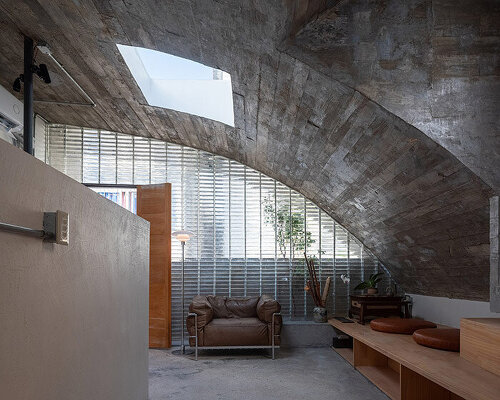Rebuilding within the fabric of guangdong’s Qiaodong Old Town
Xuebei Home is hidden along a narrow lane in Qiaodong Old Town in Guangdong, where the buildings lean close enough for neighbors to exchange words through their windows. Designed by architect Huang Yimin of GongHe Construction Architectural Studio, the concrete project rebuilds an ancestral dwelling on a 44-square-meter (474-square-foot) plot. What emerged is a careful exercise in spatial negotiation, an act of renewal that acknowledges the intimacy of Guangdong’s urban villages.
When the Li siblings first approached Huang to rebuild their childhood home, the site had collapsed into ruin — walls split, beams rotted, vegetation reclaiming the structure. What remained were mainly memories. Rather than replicating the original house, the new design seeks to re-establishing the family’s connection to place through design.
an ancestral home is rebuilt within the dense alleys of Qiaodong Old Town | images © Wang Ce
a vertical home tucked into Xuebei street
While Xuebei Home is enveloped by its taller neighbors of Guangdong’s Qiaodong Old Town, only a sliver of sky is revealed above. To open the space without disturbing the fragile balance between properties, Huang introduced a sequence of small voids, or punctures that allow light and air to pass through. The interior is organized vertically: a communal room and kitchen occupy the ground floor, two bedrooms sit above, and a reading loft rests beneath the curved roof.
The walls are cast in exposed concrete, their wood-grain texture transferred from recycled formwork. Each surface records the labor of construction — the subtle imprints of timber and the irregular seams of poured concrete — transforming the structure itself into a chronicle of rebuilding. The decision to leave the material unfinished was both practical and aesthetic, reducing maintenance in Huizhou’s humid climate and allowing the house to age naturally within its surroundings.
a 44-square-meter plot serves as the foundation for the renovation
celebrating imperfect, handcrafted space
Construction of Guangdong’s Xuebei Home began in mid-2021 under challenging conditions. With minimal access for machinery and materials, every phase demanded improvisation. The foundation revealed unstable soil; the structure had to adapt. Workers poured a raft slab by hand, navigating weather delays and tight clearances. Huang remained on site through much of the process, often mediating between neighbors as much as between drawings and reality.
This slow method of making, a resistance to standardized construction, brings a lived character to the building. The rough concrete surfaces, slightly irregular joints, and repaired edges form an honest texture that corresponds to the layered history of the lane.
the design by Gonghe Construction Architectural Studio preserves traces of the client’s memories
Guangdong’s climate shaped the building’s rhythm. The architect oriented the plan for natural cross-ventilation, with north-south openings channeling air through each level. Narrow vents at the base and roof edges sustain airflow even when the house is closed. The wooden doors and windows, assembled with traditional mortise-and-tenon joints, breathe with slight permeability, softening the sealed atmosphere typical of modern aluminum systems.
Inside, breezes move gently between volumes, while light filters through small fan-shaped windows angled to prevent direct views between houses.
exposed concrete walls carry the imprint of recycled timber formwork
At the top, two intersecting concrete arcs define the house’s silhouette. The larger canopy extends outward, sheltering a small terrace where one can sit facing a church that stands beyond the lane. This detail is an echo of the client’s wish to play the violin toward the church.
Beneath the curving roof, a bed is built into the corner. The view outward is partial, framed by parapets and neighboring eaves. Rainwater collects along the curve, falling into a narrow garden below where ferns and moss take root in the damp concrete. The building becomes both vessel and landscape, sustaining small forms of life within its enclosure.
natural ventilation and angled openings bring calming breezes to the compact interiors
the old garden walls are cut and opened to frame light and movement
two intersecting roof arcs define the profile and soften the weight of the structure
a built-in bed under the curved roof creates a place for rest and reflection
project info:
name: Xuebei Home
architect: Gonghe Construction Architectural Studio
location: Xuebei Street, Qiaodong Old Town, Huizhou , Guangdong, China
building area: 116 square meters (1,250 square feet)
completion: January 2025
photography: © Wang Ce
design unit: Cangbei Culture and Tourism, Gonghe Construction Architectural Studio
chief architect: Huang Yimin
design team: Huang Yimin, Wang Yue, Yang Yaozhou
The post concrete arches enclose glass block interiors of renovated xuebei home in guangdong appeared first on designboom | architecture & design magazine.

